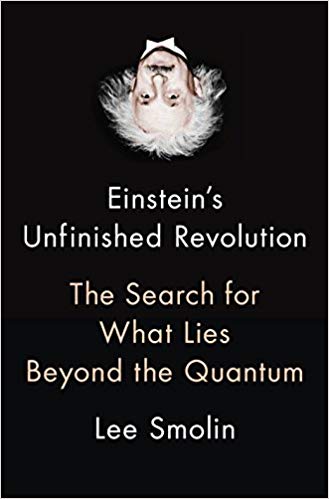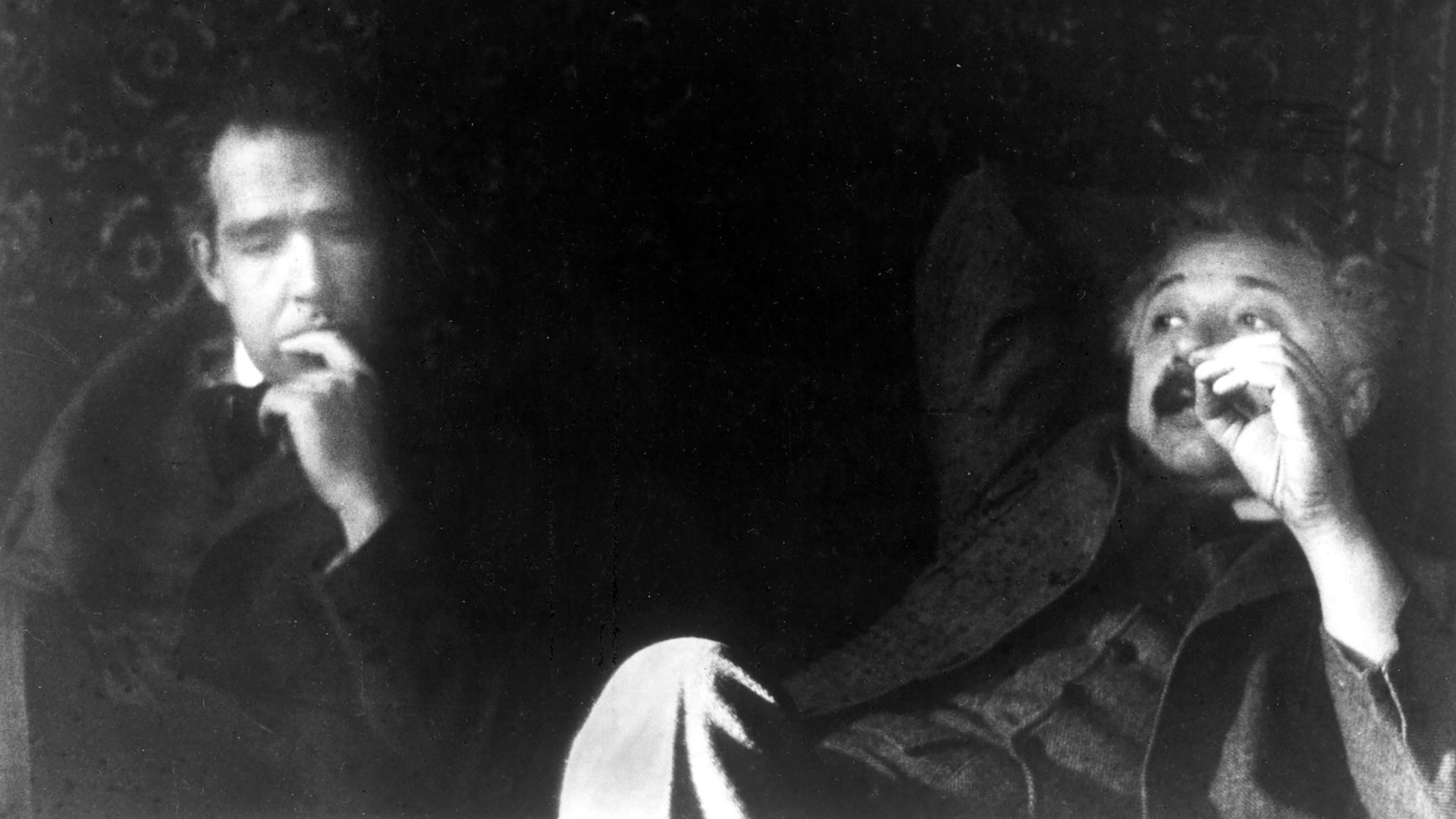One day, Albert Einstein was walking in Princeton with his biographer and fellow physicist Abraham Pais. At one point, Einstein turned to Pais and asked: “Do you really believe the moon is not there when you are not looking at it?”

BOOK REVIEW — “Einstein’s Unfinished Revolution: The Search for What Lies Beyond the Quantum,” by Lee Smolin (Penguin Press, 352 pages).
To the layperson, the question is absurd; of course the moon is still there. But then one reads a bit of quantum mechanics, and suddenly the answer is less clear.
Quantum mechanics, now just over 100 years old, describes the universe very differently from so-called classical physics (the physics of Isaac Newton). In classical physics, particles have clearly defined positions and speeds. If you measure an object’s location and speed, you can predict where it will be in the future. In quantum mechanics, however, all we can do is calculate the probability of getting some particular result when we make a measurement (of a particle’s position or speed, or some other property).
Those probabilities are governed by an abstract mathematical entity known as the wave function. Before the measurement is made, the system can be in many states at once — think of Schrödinger’s poor cat, alive and dead at the same time. When a measurement is carried out, the wave function is said to “collapse,” and just one of the various states that might have been becomes real.
And so, quantum mechanics appears to place a special emphasis on the act of observation — and thus, perhaps, on the human beings who carry out the observations. This is in stark contrast to earlier theories, which attempted to describe the universe “as it really is” — to show how its various parts move about, whether humans are there to observe the results or not. Now you see why Einstein brought up the moon: Surely the act of observation can’t matter; presumably the universe is what it is, whether we’re looking at it or not … right?
Einstein certainly hoped so, and so does Lee Smolin, the author of “Einstein’s Unfinished Revolution: The Search for What Lies Beyond the Quantum.” Smolin is an American physicist based at the Perimeter Institute for Theoretical Physics in Waterloo, Ontario; his previous books include “Three Roads to Quantum Gravity,” “The Trouble with Physics” and “Time Reborn.’’
In his latest book, Smolin’s admiration for Einstein shines through; it was Einstein’s later philosophical writings that inspired him to pursue a career in theoretical physics. And like Einstein, he takes the position that philosophers call “realist.” As he writes, “The reality that we realists seek is the world as it is, or would be, in our absence.”
Perhaps, Smolin suggests, realism can be restored if we “interpret” quantum mechanics correctly. Some quantum theory pioneers, like Niels Bohr and Werner Heisenberg, believed that the central role of probabilities meant that quantum mechanics is ultimately about knowledge. As Bohr put it: “It is wrong to think that the task of physics is to find out how nature is. Physics concerns what we say about nature.”
The theory, rather awkwardly, seems to involve us. The view that Bohr and Heisenberg endorsed became known as the Copenhagen interpretation, after the city where the two men collaborated.
But as Smolin points out, there’s another version of the theory that allows for a realist view. This is the de Broglie-Bohm interpretation (named after two other early quantum thinkers), also known as pilot wave theory. In pilot wave theory, there’s still a wave function, but, in addition, each particle has an actual, definite location, even when it’s not being observed. This makes the theory “realist”; indeed, it may sound like a throwback to the physics of Newton.
But there’s a difference: Classical mechanics was purely “local”: physical objects could only affect one another if they touched (or if they influenced each other by means of a field, like an electric field). But quantum mechanics — including the pilot wave version — is inherently nonlocal. Sometimes, two particles are governed by a single wave function; when this happens, they are said to be “entangled.” When we measure the properties of one member of an entangled pair, we instantly gain information about the other member, even if it’s far away. Einstein dismissed such interaction as “spooky action at a distance,” but numerous experiments, beginning in the 1980s, have confirmed that entanglement is real.
Smolin is drawn to pilot wave theory, but cautions that it, too, has its problems. For starters, the wave function has no geographical limits. This leads to tricky questions about the unused parts of the wave function, the parts that don’t seem to play a role in dictating where particles actually end up. As an example, Smolin imagines the wave function that describes his own life’s trajectory. (Such a wave function would be far too complex to actually figure out, but the idea is all that matters for Smolin’s purposes.) On September 2, 1998, he had been booked on Swissair flight 111 from New York to Geneva, Switzerland. At the last minute, he re-booked for a later flight. The plane he would have been on crashed off Nova Scotia, killing all 229 on board. If pilot wave theory is to be taken seriously, he writes, “a branch of the wave function of the atoms that then constituted me is to this day bunched up at the bottom of St. Margaret’s Bay, off the village of Peggy’s Cove, Nova Scotia.”
There are other interpretations of quantum theory besides Copenhagen and pilot waves. A current favorite, endorsed by thinkers such as Max Tegmark, David Deutsch, and Sean Carroll, is the many-worlds interpretation (MWI), which goes back to the work of Hugh Everett III in the 1950s. In the many-worlds view, the wave function never collapses; rather, every time a quantum system can evolve in one way or another, it does both. Everything that can happen does happen — but in separate universes.
If MWI is right, Smolin lived and died on September 2, 1998; each statement is true, but in a different world. To Smolin, this “sounds more like science fiction than science”; in the end, he believes that MWI raises more questions than it answers. In brief, he finds every version of quantum mechanics unsatisfying. Having said that, it’s worth remembering that quantum mechanics works; depending on how you measure it, its predictions have been confirmed to 11 or perhaps even 14 decimal places. (The problems come up when we ask what the theory means.)
By this point we’re about halfway through the book, and Smolin, having highlighted quantum theory’s shortcomings, begins to look for a path forward. And he’s not afraid to use the widest of wide-angle lenses. What do we mean when we speak of causes and effects? Are space and time real? Is one of them more fundamental than the other? (Yes: In Smolin’s view, time is more basic, while space may be “emergent.”)
On what might we anchor a fundamental physical description of the universe? Here, Smolin takes us back to the work of the 17th century German philosopher Gottfried Leibniz. Smolin admires Leibniz’s “principle of sufficient reason,” which says, roughly, that every time we find that the universe could have been like this or like that, we can also find, with further investigation, why it is one way and not the other. He’s also drawn to the “relational” view of physics espoused by Leibniz: While Newton argued for a fixed backdrop of absolute space and time, against which physical objects moved about, Leibniz recognized that objects and events can ultimately be described only in relation to other objects or events.
It takes a lot of chutzpah to abandon the bulk of modern physics, and then build it back up in a more coherent fashion from first principles. This is Smolin’s ambitious goal. Needless to say, he doesn’t quite pull it off — but he leaves us with provocative ideas that deserve attention. One of these is his proposed “causal theory of views.” We’re asked to imagine what the universe looks like from the point of view of each individual event. Smolin treats these as fundamental, and attempts to build up space and time — indeed, the rest of physics, including quantum mechanics — from there. If things go well, Smolin will have made the universe safe for realism; if they go badly, he will have filled up quite a few notebooks for nothing. (Thankfully, along with the chutzpah, there is humility. Describing his other work, he says: “This theory is new, and, as is the case with any new theory, it is most likely wrong.”)
I do not believe in ghosts — but if I did, I would picture the ghost of Einstein looking down and saying: “Keep trying. Don’t give up.”
Dan Falk (@danfalk) is a science journalist based in Toronto. His books include “The Science of Shakespeare” and “In Search of Time.”











Comments are automatically closed one year after article publication. Archived comments are below.
This is one of the big weaknesses of MWI: Born’s rule, which determines the probabilities, has to be bolted on. It does not arise naturally out of the interpretation, although there have been some (in my view fairly unconvincing) attempts to argue for it. Sean Carroll’s argument, for example, requires recasting the question of “why do we observe X with probability P(X) and Y with probability P(Y)?” into a completely unrelated question about Bayesian observers who are uncertain as to which universe they are in after a measurement has been made but before the result is known. It’s a nice argument, but it doesn’t answer the interesting question.
The Born rule follows rigorously from the quantum logics approach to quantum theory! See:
https://www.amazon.com/Geometry-Quantum-Theory-V-S-Varadarajan/dp/0387493859
I don’t think observation deserves any special consideration at all. After all, an observer, whether that’s us, or an instrument is just another set of physical system(s). Subjectivity is not required to explain collapse at all. Collapse is not simply an on-off switch either, but rather a gradient. Collapse is really to do with the quantum system and its interaction with an external system. If that external system has a large degree of freedom, the superposition effect is simply unobserved and ‘spreads’ to the bigger composite system of quantum particle plus observer.
A simple double-slit experiment showed this.
https://www.nature.com/articles/nature02276
This experiment basiaclly showed that firing C70 moelcules at a double slit gave interference patterns, but as the temperature is slowly turned up, the interference pattern slowly faded. Why? Not because there was any observer, but because as the temperature rose, the test particles had a greater chance to interact with molecules of its surrounding, its superposition ‘spreading’ to that greater composite system, losing the observable interference effect.
What does degree-of-freedom have to do with anything? A quantum system is described by a wavefunction, which evolves in time as a function of its energy E. Basically, its energy determines its frequency. When a wave interacts with another wave with a similar frequency, interference occurs, but if it interacts with a a bunch of waves of very different frequency, it becomes submerged and indistinguishable in the noisy wave, just like in water, in light in sound. A system with high degree of freedom is like the noisy wave, composed of lots of subsystem of lots of different energy, and so frequency, and so the interference effect is suppressed. This is basically the theory of decoherence, describing quantum interaction. Note that this theory adds no new maths or interpretation to basic quantum theory at all, just considers the environment/observer as another physical system.
Conversely, it is possible for a macrosystem to be composed of coherent subsystems (subsystem with similar energy/frequency), and interference effects can exist macroscopically! These decoherence-free-subspaces is probably important to developing quantum computers.
Decoherence is not any more mathematically difficult than basic quantum theory, but very important in understanding the quantum to classical transition and really important in understanding the fundamentals of quantum plus supplements discussions of different interpretations. It’s a mystery why its not more recognised. Perhaps because it goes against the popular ‘quantum consiousness’ stuff.
Is it that difficult to allow into the picture an intelligence that observes it all into existence? It might take a great deal of humility but ancient belief systems in the orient have understood quantum physics experientially for a very long time. John Horgan asked of David Albert why ”quantum mechanics inspires so much New Age nonsense.” Neither had the confidence to consider the possibility that it isn’t nonsense. It certainly isn’t new, either. It wouldn’t take a huge leap to consider that we are the results of some greater mind’s fantasy…just a small step back into humility.
I have been debating on buying this book and am now convinced I should. Thanks!
I think I have to quote Janis Joplin here. ” It’s all the same f’n day man.”
The problem lies in conceiving the separate existence of an A or a B. The concept is flawed . The conceiver is confused and the perceived entities A and B are neither. Entanglement works because distance is an illusion as is time.
Quantum theory is best understood as a form of perspectivism not physicalism.
Nietzsche introduced the idea of perspectivism: in the final analysis, all we really have is a manifold of interlocking perspectives. For example, consider the following toy model. If humans are small finite, represent each possible human perspective by a small non-empty subset of {1,…,n} where n is a large natural number. Then, there are minimal perspectives, but no maximal human perspective. Still, there is an ideal finite perspective which sees everything! If n=infinity, then there is still an ideal infinite perspective which sees everything! (God’s eye-view!) If one accepts the standard quantum logic, then one has a manifold of perspectives which cannot-by Gleason’s Theorem-be embedded into any single perspective! There are now maximal perspectives, but no universal perspective! (Theologically, this requires accepting polytheism!! Alternatively: Even God suffers from cognitive dissonance!! ;-) )
I have yet to understand what the MWI system does with unequal probabilities. Suppose that the chance of an event is observed to be A 1/3 of the and B 2/3 of the time. Does that mean there are 2 copies of B?
What happens when the probability of A is 1/square root 2, and B the remainder?
In universe A the probability of the event is p (A). In universe B it is p (B). This can of course be generalized, but even in the simplest cases an unholy amount of universe creation is needed. An MWI “splitting” event needn’t involve an entire new universe, but perhaps only a limited region within a Planck length (hG/2πc3)1/2 , or within some 10 to the minus 35 meters of the event. Beyond that “distance” everything else might remain unaffected, avoiding the snowballing messiness of Everett’s thesis. At the Planck scale, today’s physics breaks down anyway, and things become intrinsically unknowable. It is not as though someday somebody will figure out what happens there, it cannot ever be known. All the celebrated “weirdness” of quantum physics stems from a rational mind’s refusal to admit it has reached an epistemological endpoint. When an excited electron in an atomic field changes state (energy level, say) nothing “jumps” or even smoothly “moves”, the words have no meaning there. The new state instantaneously comes into existence if the probability wave function’s evolution allows it. Decoherence among entangled entities occurs very, very quickly, and the known laws of physics must be ignored “down there”. Quantum behavior may not even follow causality. Why does quantum behavior exist at all? Maybe it’s because a continuation of rational behavior at extremes of space and time inevitably produces a jammed clockwork mechanism.